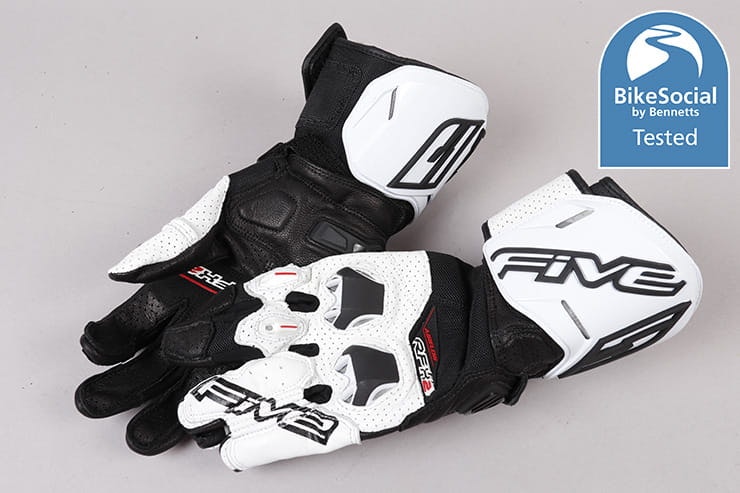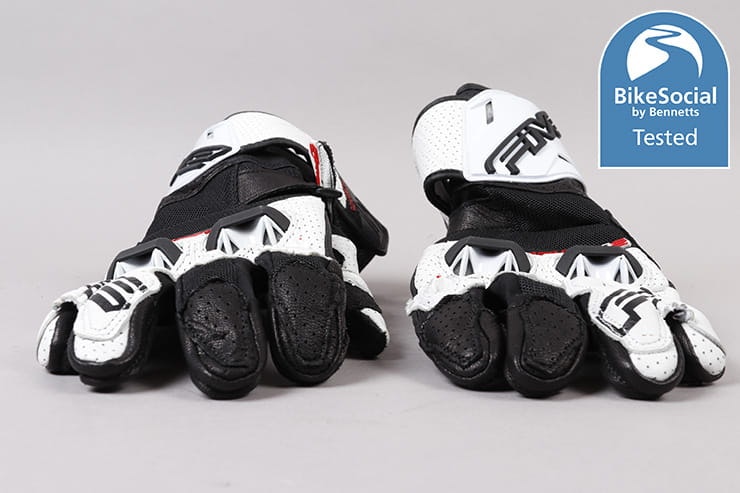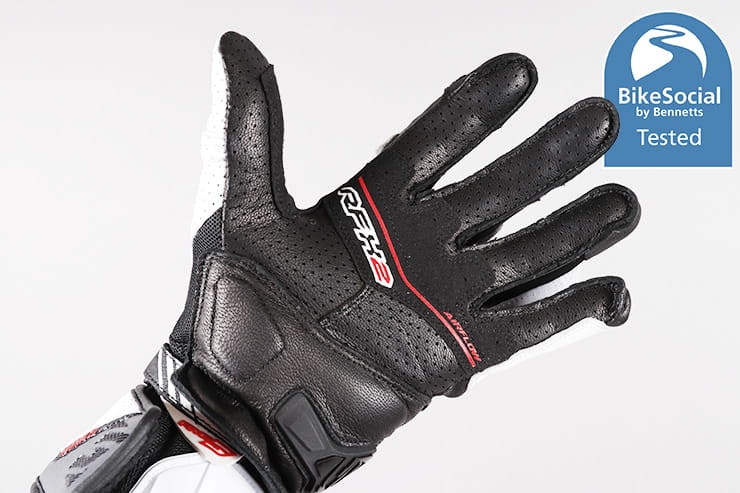Five RFX2 Airflow review | Level 2 ventilated race gloves tested
By John Milbank
Consumer Editor of Bennetts BikeSocial
26.07.2023
Date reviewed: July 2023 | Tested by: John Milbank | Price: £169.99 | five-gloves.com
The Five RFX2 Airflow gloves on review here are truly outstanding, given the exceptional levels of ventilation they offer along with great comfort.
Some manufacturers will tell you that you can’t have high levels of protection AND comfort, but Five appears to have blown that idea clean out of the water with the RFX2s. I’ve been wearing them for several months on an R1250GS, ZX-6R and a VFR800 to find out if they’re worth the money…
Incredible level of ventilation
The highest level 2 protection
Excellent wrist restraint
Cuff a little clunky
Construction, fit and feel
The Five RFX2 Airflow gloves are a combination of goat leather and mesh fabric, with the majority of the leather – except the palm overlays – being perforated.
The sides of the fingers use a stretch material that makes for an extremely comfortable fit, but that also allows even more air onto the hands.
Despite additional layering on the palm, feel at the controls is very good, helped no doubt by the excellent flexibility of these gloves. When first putting them on, the RFX2s felt a little tight, but almost immediately bedded in and are now outstandingly comfortable.
Synthetic leather is used at the top of the palm and inside the thumb to add protection and grip, while clever use of an accordion panel on the thumb keeps the fit tight without compromising movement.
Overall, a lot of thought has clearly gone into the build of these gloves, and while Five doesn’t seem to be the first brand considered by many UK riders, if the other kit is anything like this, we’d like to see more.
Protection and certification
Here at Bennetts BikeSocial we want people to be able to buy riding kit armed with all the knowledge possible. When it comes to safety, knowing what protection is offered is only possible with independent, certified testing, and for gloves, that’s EN13594:2015, which has two levels – Level 1 and Level 2.
The Five RFX2 Airflow gloves are certified as Level 2, the highest protection available.
The RFX2’s knuckles are protected by raised air intakes, followed by padding and a Kevlar insert, while the palms have additional leather layering, padding and a thermoplastic rubber (TPR) insert on the lower outside edge. TPR should help distribute impact energy, protecting the hypothenar muscle group and bone underneath, and act as a slider to reduce the risk of damage caused by the palm grabbing in a slide and the wrist over-extending.
The outside edge of the little finger has extra leather layering it up, which also extends – via an accordion panel – to the third finger, to reduce the chance of the little digit getting pulled away during a slide.
The key impact areas of the RFX2s are very well made, with layers of additional leather at the palm and a Kevlar insert below the knuckle protectors. I was at first concerned about the mesh area below the thumb, which could catch the road in some scenarios, but a Kevlar patch is installed here too.
Perforations in leather are often used in riding kit, but in some cases these holes are kept away from seams to avoid creating a weaker point. This works well in large areas, like the chest, but on gloves it’s a lot harder to manufacture. The leather used in the RFX2 Airflows is entirely perforated, but there are significant reinforcements in the hardest hit zones (like the palms and outside edge of the hand). The only area that seems to let down these gloves is at the webs of the fingers: here some of the stitching gets close to the edge and in some cases jumps across a hole, but while I was a little concerned about the stretch material on the sides of the fingers and webs, this is kept away from the road and should be no more likely to burst open at the seams than if it were leather.
A hugely valuable guide to motorcycle clothing safety is Motocap in Australia, which tests a lot of the gear sold in that region. The RFX2 Airflows have been tested, and did very well in abrasion testing but not so good in the burst test, however the design of the gloves now on sale is different to the ones tested in 2020: the newer model, launched in 2021, seems to have more leather on the thumb, redesigned panels and a new cuff protector.
We will never accept companies that claim their products are safer than others without proof via independent testing as you can only truly judge and compare kit’s performance in the chaotic real world of a crash with lab testing, and Five has clearly done what it takes to meet the requirements of Level 2, putting these gloves into the elite group that has achieved this.
Where the certification standards that ALL gloves must comply with deem to be the key areas of greatest risk, the Five RFX2s have been shown to meet or exceed the performance necessary for the highest level in abrasion resistance, seam strength and burst strength. Given the incredible ventilation and comfort that they offer, that’s quite an achievement.
All motorcycle clothing sold in the UK and Europe is deemed to be Personal Protective Equipment (PPE). This is a good thing for riders as it can help them choose kit that has provable levels of safety as to meet this legislation, it must be tested to a recognised standard. To fully understand the labels found in all bike kit, click here.
Warm and cold weather use
Given the large amount of ventilation on the Five RFX2 Airflows, it should come as no surprise that these are intended as warm weather gloves only. Even on a bike with wind deflectors on the bars, the cooling breeze is very impressive, and if your hand’s in the airflow, it feels the closest I’ve ever had to wearing no gloves at all.
I haven’t noticed any dye leaching with these gloves, though I also haven’t had sweaty hands yet.
Wet weather use
Needless to say (surely?), the RFX2s are not intended for wet weather use. If you do get caught out in a downpour, as with all leather gloves just put them to one side with plenty of air movement and allow them to dry naturally – don’t force dry them with heat or by placing them on a radiator as it’ll damage the hide.
Fastening
The wrist restraint on the Five RFX2 Airflows is very effective in preventing the gloves being pulled off in a crash, and tucks easily under a flap of leather at the palm when closed. The end of the wrist strap is also flared, so it can’t pull out of the plastic buckle.
The cuff is fastened with a large Velcro panel and stays in place well, though I found that with it cinched up fully the end of the fastener pokes out a little. It doesn’t catch on anything, but a little more length of Velcro for it to attach to would have looked tidier. Though it would also mean shortening the plastic panel that forms a protective barrier around the wrist.
Lining
The RFX2 Airflows are only lined inside the cuff and on the top of the hand. It’s not noticeable at all, and thanks to the incredible ventilation, it never feels sweaty.
Touchscreen compatibility
The Five RFX2 Airflow gloves are not touchscreen compatible, which is a shame though not totally uncommon on sportsbike gloves.
Four alternatives to the Five RFX2 Airflow gloves
There are very few gloves that meet the higher Level 2 of protection, so if you’re looking for the safest hot-weather gloves, your choice will be very limited. Here are some others to consider though…
Alpinestars GP Plus R2 | These gloves aren’t as brilliant in high heat as the RFX2s, and they’ve not been tested and proven to meet Level 2, but they did do very well in Motocap testing and are extremely comfortable. If you’re after a quality sportsbike glove, they’re highly recommended. Read the full review of the GP Plus R gloves here.
Oxford Nexus 1.0 | At £99.99, the Oxford Nexus are great value Level 2 gloves. They’re a little more prone to getting hot inside than some others, but they’re otherwise extremely comfortable. Keep checking the honest, in-depth glove reviews at Bennetts BikeSocial, as these will feature soon.
Goldtop Predator | If you’re after cool summer gloves, but don’t want a full gauntlet, try some short cuff designs like these, which have a silk lining. Read the full review of the Goldtop Predator gloves here.
BKS Summer Gloves | Designed for police riders who wanted a short-cuff glove, these from BKS Made to Measure (not to be confused with the BKS kit sold at J&S) are extremely tough and would likely be capable of passing Level 2 if it weren’t for the fact that all Level 2 gloves must have a long cuff. Read the full review of the BKS Summer Gloves here.
These are just four of many alternatives – you can find all the motorcycle gloves we’ve tested here and be sure to regularly check for the discounts available through Bikesocial membership.
Five RFX2 Airflow gloves review: Verdict
The Five RFX2 Airflow gloves have achieved the highest levels of protection under the current certification standards, and have some good design features in the most critical areas. There are plenty of ventilated and mesh gloves that meet the minimum legal requirement of EN13594 Level 1, but these are the only highly ventilated ones that I know of at the time of writing to have passed the abrasion, seam and burst tests required to beat Level 2, making them the provably safest hot-weather motorcycle gloves on the market.
What’s most outstanding is of course the exceptional ventilation performance, and combined with their glorious comfort, the Five RFX2 Airflow gloves are well worth considering for any summer rider, especially if you’re heading off into even the hottest climates. Five says they’re ideal for sportbikers, but I’ll be wearing these on my GS and VFR, as well as my ZX-6R and any other bike when the sun’s out.
If you’d like to chat about this article or anything else biking related, join us and thousands of other riders at theBennetts BikeSocial Facebook page.


